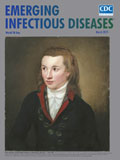
Volume 25, Number 3—March 2019
Research Letter
Management of Patients with Candida auris Fungemia at Community Hospital, Brooklyn, New York, USA, 2016–20181
On This Page
Abstract
Candida auris is an emerging fungus that can cause invasive infections. It is associated with high mortality rates and resistance to multiple classes of antifungal drugs and is difficult to identify with standard laboratory methods. We describe the management and outcomes of 9 patients with C. aurisfungemia in Brooklyn, New York, USA.
Candida auris is an emerging fungus that can cause invasive infections associated with high mortality rates and is often resistant to multiple classes of antifungal drugs. Risk factors for infection include nursing home exposure; invasive devices, such as tracheostomy tubes or percutaneous endoscopic gastrostomy tubes; immunocompromised status; and use of broad-spectrum antimicrobial drugs (1). On the basis of limited data available, echinocandins are recommended as initial therapy for C. auris infection (2). We review the management of 9 case-patients who had C. auris fungemia at a 300-bed community hospital, attached to a 450-bed nursing home, in Brooklyn, NY, USA. There have been 9 occurrences of C. auris fungemia at this institution since 2016.
Our case series demonstrates the complex patient population at risk for invasive infection with C. auris. Patients infected were generally >70 years of age and had multiple chronic concurrent conditions (Appendix Table). Most patients came from nursing homes, and more than half had invasive devices, such as tracheostomies or percutaneous endoscopic gastrostomy tubes, placing them at high risk for infection at baseline.
In addition, each patient had a recent history of broad-spectrum antimicrobial drug use; many had concomitant resistant organisms isolated and received concomitant antimicrobial drug therapy during their C. auris treatment course. The most common antimicrobial drugs used were meropenem, polymyxin B, and vancomycin. Common bacteria isolated were Acinetobacter sp., Pseudomonas aeruginosa, and Klebsiella pneumoniae. Four patients were admitted to the medical intensive care unit; 2 had prolonged stays in the medical intensive care unit before development of candidemia.
The time from hospitalization to initial infection with C. auris varied among the patients. Approximately 60% of the patients came to the hospital with positive blood cultures on day 1, and fungemia developed in the remaining patients after prolonged hospitalization. Most patients had documented clearance of their blood cultures within 3–5 days of initial isolation. However, 1 patient had a second episode of C. auris fungemia several weeks after he was initially given treatment and documented to have clearance of blood cultures.
All patients were given micafungin as first-line therapy for an average duration of 22 days. The most common dose used was 100 mg/day of intravenous micafungin. Two of the 9 patients required liposomal amphotericin B after failing to respond to micafungin therapy. Both of these patients remained persistently febrile while receiving micafungin monotherapy; 1 was the patient with 2 episodes of C. auris fungemia. The average duration of amphotericin B was 19 days. The in-hospital mortality rate was 22%. Of the 7 patients who were discharged, 43% were discharged to a palliative care service. The average duration of hospitalization for these patients was 65 days.
Limited information is available on interpretation of MIC data for C. auris because the Clinical Laboratory Standards Institute (https://clsi.org) does not have breakpoints specific for C. auris. Antifungal susceptibility data were determined for each of the patients included in this case series (Appendix Figure). All antifungal susceptibility tests were performed by the Wadsworth Laboratory, the New York State Department of Health Reference Laboratory (https://www.wadsworth.org). Most susceptibility information was not available throughout the course of treatment. Given difficult identification of the organism by using standard laboratory techniques, timely identification and antimicrobial susceptibility information continues to be a challenge when managing patients with invasive C. auris (3).
All isolates were markedly resistant to fluconazole, and ≈40% were resistant to liposomal amphotericin B (Appendix Figure). This second finding is of particular concern because liposomal amphotericin B is the recommended second-line agent for management of C. auris in the setting of micafungin failure. On the basis of the resistance patterns at this hospital, patients who failed monotherapy with micafungin had lisposomal amphoterin B added rather than switching therapy completely.
We encourage clinicians treating C. auris infections to consider combination therapy with micafungin plus liposomal amphotericin B in patients who fail monotherapy with micafungin. Laboratory limitations mean that timely identification and susceptibility testing of C. auris might not always be possible, and clinicians might often have to defer to local or national epidemiology trends to make the most up-to-date decisions. It is essential to notify the department of health of new cases of infection with C. auris as soon as possible and to educate healthcare personnel to help minimize spread. Clinicians should focus on identifying and minimizing risk factors for acquisition of C. auris and prevention of spread through enhanced infection control procedures.
At the time of this study, Dr. Park was a pharmacy resident in the Department of Pharmacy, Kingsbrook Jewish Medical Center, Brooklyn, NY. She is currently an infectious disease resident at the State University of New York Downstate Medical Center, Brooklyn, NY. Her primary research interest is assessing the appropriate use of antimicrobial drugs and associated long-term outcomes.
References
- Centers for Disease Control and Prevention. Candida auris [cited 2017 Nov 21]. https://www.cdc.gov/fungal/candida-auris/index.html
- Centers for Disease Control and Prevention. Recommendations for treatment and prevention of Candida auris [cited 2017 Nov 21]. https://www.cdc.gov/fungal/diseases/candidiasis/c-auris-treatment.html
- Centers for Disease Control and Prevention. Recommendations for identification of Candida auris [cited 2017 Nov 21]. https://www.cdc.gov/fungal/diseases/candidiasis/recommendations.html
1Preliminary results from this study were presented as a poster presentation at the American Society of Health-System Pharmacists Midyear Meeting, December 3–7, 2017, Orlando, Florida, USA.
2Current affiliation: State University of New York Downstate Medical Center, Brooklyn, New York, USA.
3Current affiliation: St. John’s University College of Pharmacy and Health Sciences, Queens, New York, USA.






















.png)











No hay comentarios:
Publicar un comentario